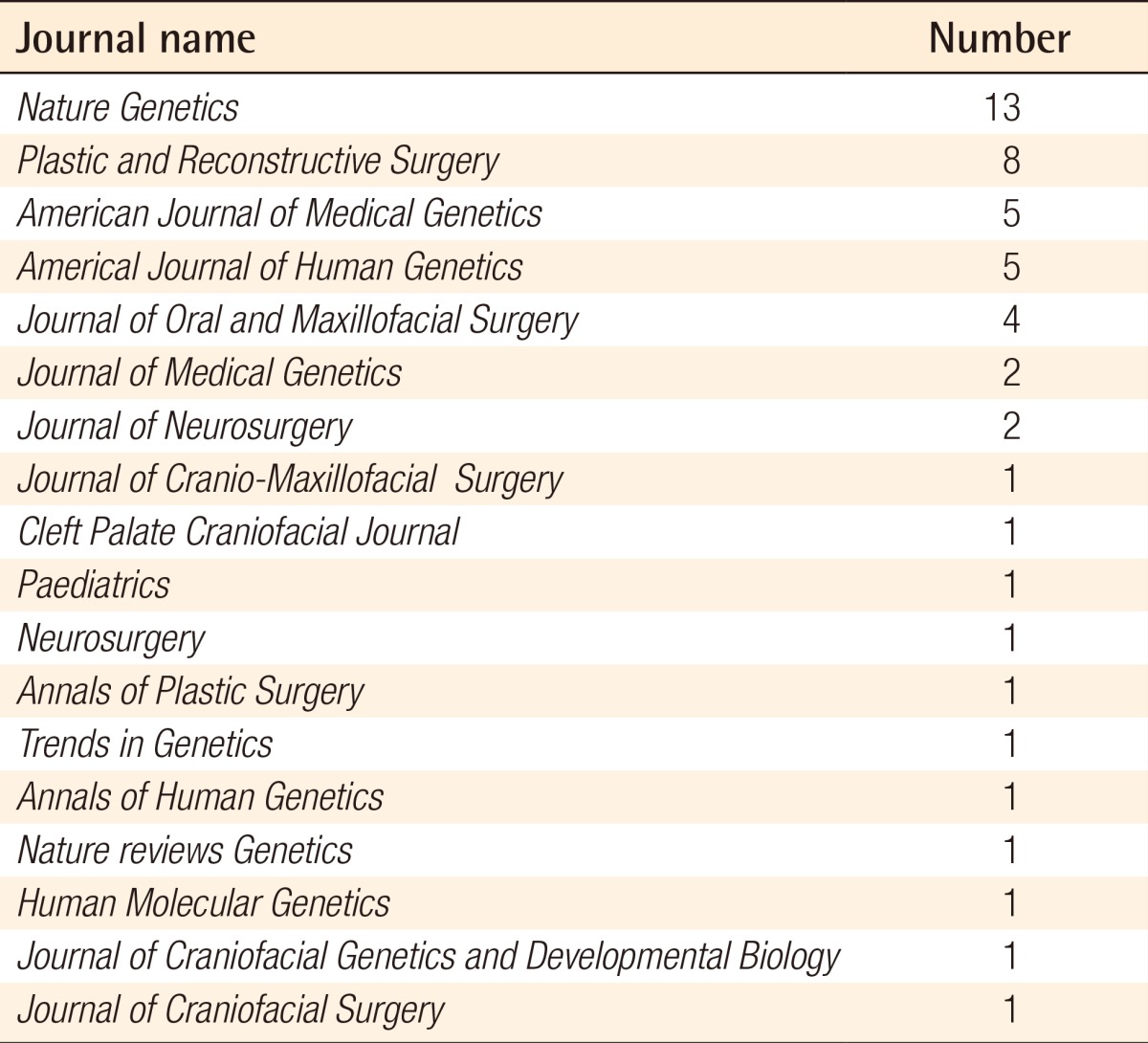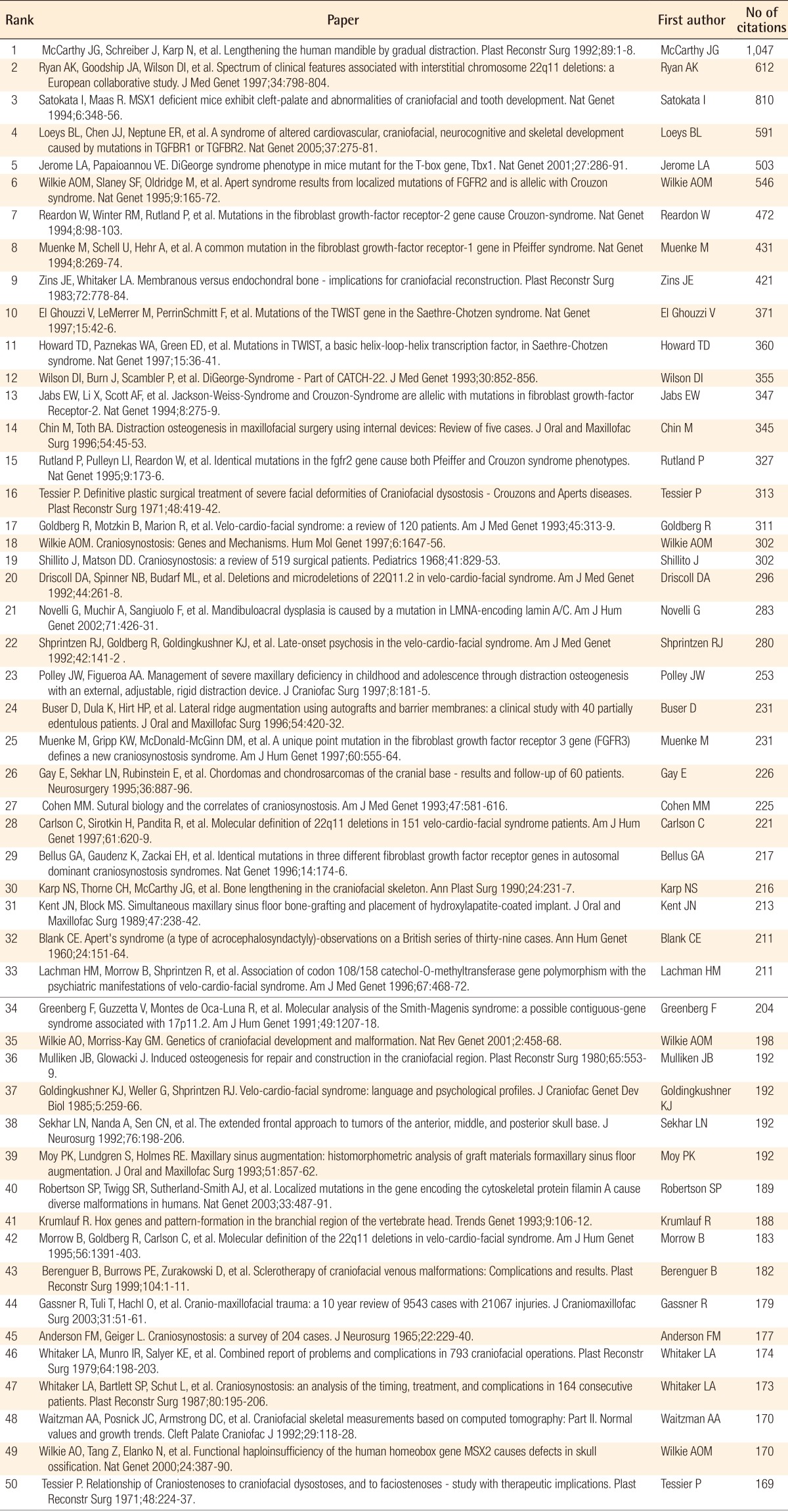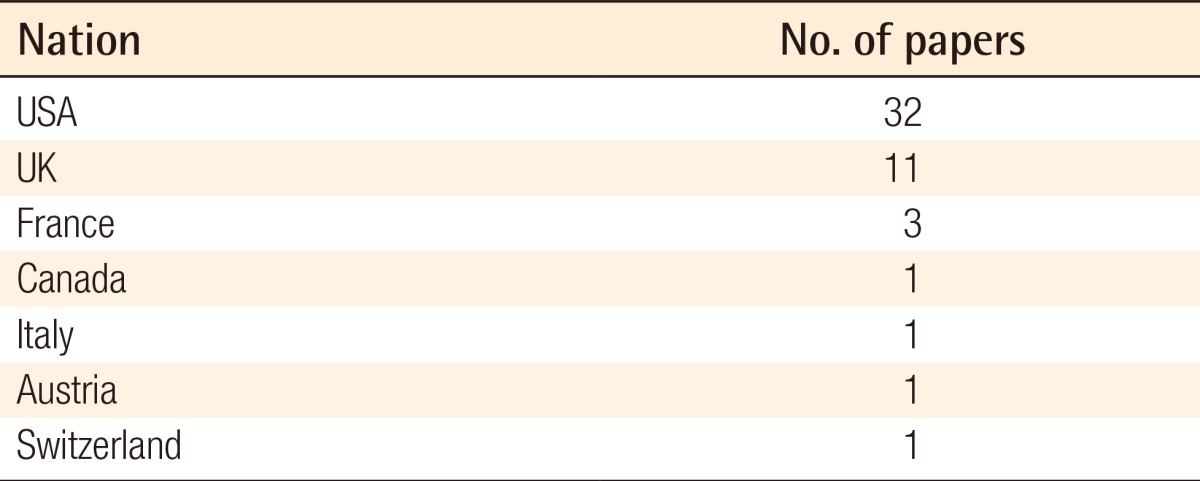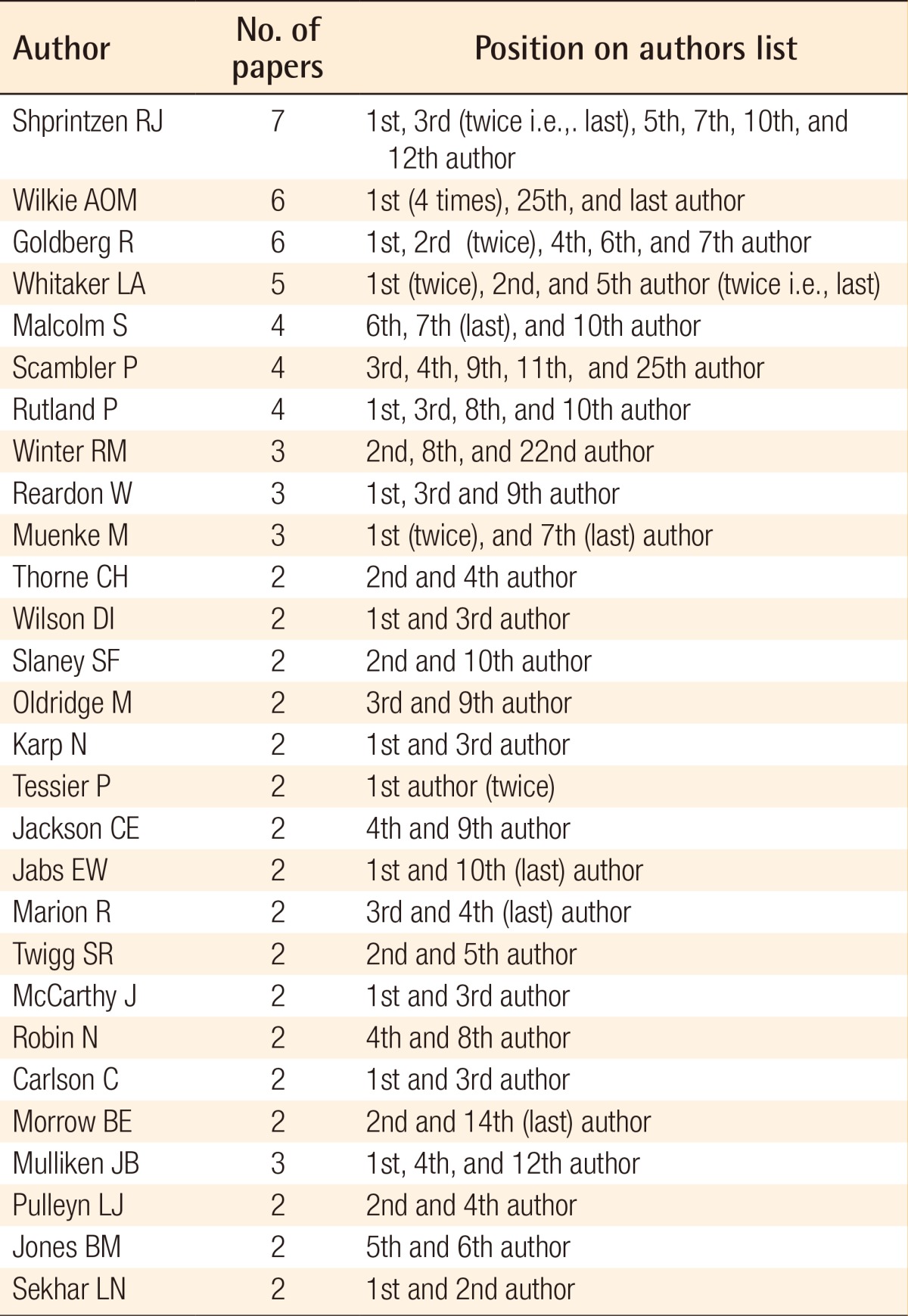The 50 Most Cited Papers in Craniofacial Anomalies and Craniofacial Surgery
Article information
Abstract
Background
Citation analysis is a recognized scientometric method of classifying cited articles according to the frequency of which they have been referenced. The total number of citations an article receives is considered to reflect it's significance among it's peers.
Methods
Until now, a bibliometric analysis has never been performed in the specialty of craniofacial anomalies and craniofacial surgery. This citation analysis generates an extensive list of the 50 most influential papers in this developing field. Journals specializing in craniofacial surgery, maxillofacial surgery, plastic surgery, neurosurgery, genetics and pediatrics were searched to demonstrate which articles have cultivated the specialty within the past 55 years.
Results
The results show an intriguing compilation of papers which outline the fundamental knowledge of craniofacial anomalies and the developments of surgical techniques to manage these patients.
Conclusions
This citation analysis provides a summation of the current most popular trends in craniofacial literature. These esteemed papers aid to direct our decision making today within this specialty.
INTRODUCTION
Craniofacial anomalies represent a diverse group of congenital disorders. They occur due to the abnormal development of the bones and associated soft tissues of the skull and face. Craniofacial syndromes can be divided into those affected by the premature fusion of the cranial sutures (craniosynostosis) and those affected by clefts [1].
Craniosynostosis occurs in 1 in 2,000 of the population. Syndromic craniosynostoses, such as Crouzon and Apert syndromes occur in 1 in 10,000 and 1 in 150,000 live births respectively [2]. Commonly seen craniofacial conditions in children include suture synostosis, Apert, Crouzon, Saethre-Chotzen, Pfeiffer, midfacial clefts, microsomias, and cephalic abnormalities. These developmental disorders have far reaching consequences on the airway, appearance, cerebral development, hearing, sight, dentition, speech and psychological well-being of these patients. Surgical management comprises of distraction techniques, orthognathic procedures and tumor resections. Owing to the wide array of surgeries within this field, multidisciplinary input becomes a requisite [3].
Over the years, newly recognized associated craniofacial syndromes and advances in surgical procedures have been documented in the literature by different specialties. Due to the diversity of specialties involved in this area, it is extremely difficult to be aware of the most influential papers. The citation frequency of a published paper determines its influence within it's specific field. A citation is a numerical abbreviation embedded within the text of an article, which refers to and acknowledges another author's work. Citation analysis is a recognized bibliometric method whereby papers are ranked according to the number of times they have been referenced. Hence, citation analysis is an established method to determine the degree of influence of a paper within a specialist field. The purpose of a citation is also to ascertain the impact of an important piece of work contributed by a specific author. The impact factor (IF) of a scientific journal is a measure of the number of citations it's published articles have received [4]. It is a calculation based on the number of citations a journal has obtained in the current year to items published over the previous two years, divided by the substantive articles published over the previous two years [56]. The higher the IF of a journal, the more prestigious it becomes within the scientific community which it serves [7]. As a result, the IF of the publishing journal is also enhanced when a key paper is within its bibliography. Although the validity of this method is disputable in defining a journal's worth, many scientific journals still aim to improve their IF, recognizing this as a fundamental marker of journal quality [89]. Several articles on citation classics have been published in various specialities including anaesthetics, general surgery, otolaryngology, plastic surgery, radiology and orthopaedics [101112131415]. However, there has never been a bibliometric analysis of the most cited papers in the field of craniofacial anomalies and surgery. In this study, we have performed a citation analysis to evaluate the 50 most influential papers in craniofacial anomalies and surgery over the past 55 years.
METHODS
The database of the Science Citation Index (SCI) of the Institute for Scientific Information (ISI) was utilized in order to identify the most cited papers in craniofacial anomalies and surgery [16]. This is an online index of citations, available through the Web of Science database, which is part of the Web of Knowledge collection of databases. In our search performed between March and April 2015, 64 international scientific journals were included (Table 1). The included journals consisted of craniofacial, plastics, maxillofacial, genetics and paediatric journals with high IF. Only 18 of these 64 journals contributed to the top fifty most cited articles. Papers that dealt exclusively with cleft lip and palate were excluded from the search as citation analysis on this subject has been published before [17].
The database was searched using filter terms of 'craniofacial anomalies', 'cranial synostosis', 'Apert's syndrome', 'Crouzon's syndrome', 'Pierre Robin Sequence', 'Treacher Collins', 'Nager syndrome', 'Pfeiffer syndrome', 'Goldenhar', 'microsomia', 'facial clefts', 'plagiocephaly', trigonocephaly,' 'brachycephaly', 'scaphocephaly', 'distraction osteogenesis', 'maxillary/mandibular advancement', 'monobloc', 'orthognathic', 'cranial vault', 'skull base surgery', ' Lefort 1', 'tumors' and 'trauma'. Once the fifty most cited papers were identified, a further analysis of each paper using criteria described by Paladugu et al. [11] was performed. This involved evaluating each individual paper to reveal it's subject matter, authorship, article type, institution and year of publication.
RESULTS
Table 2 represents the fifty most cited papers in craniofacial anomalies and craniofacial surgery, in descending rank order of citations received. The total number of citations per articles ranged from 1,047 to 169 (Table 2). The most influential paper was cited 1,047 times and was published by McCarthy et al. in 1992. This seminal article described a novel technique to lengthen the mandible by gradual distraction. Four patients were recruited and the concept was that this technique would provide early reconstruction of craniofacial defects without the need for bone grafts, blood transfusion or intermaxillary fixation (Table 2). The second most frequently cited paper by Ryan et al consisted of a European collaborative study determining the features of 22q11 deletions. This was a large multicenter trial consisting of 11 UK institutes and 12 institutes from seven other European countries. Data was obtained regarding 558 patients with DiGeorge syndrome to elucidate a spectrum of clinical features to aid in its recognition (Table 2). The next most cited papers deal with the recognition of mutations in Msx1 (MSH homeobox 1), TBX (T-box), FGFs (Fibroblast Growth Factor) receptor and TWIST genes in the genesis of Apert, Crouzon, Pfeiffer and Saethre-Chotzen syndromes. The 9th most cited paper was published by Zins et al in 1983 and it compared the use of membranous versus endochondrial bone in craniofacial reconstruction. It is not until the 14th position that the next surgical paper is ranked in the top 50 list. It was published by Chin et al. in 1996. The subject matter again comprised of distraction osteogenesis and advocated its use to eliminate scarring, improve patient compliance and improve stability when compared to the biphasic systems that were in use at that time.
Nature Genetics published thirteen of the most cited papers, establishing it as the journal with the highest number of papers in the top 50 list (Table 2). The surgical journals Plastic and Reconstructive Surgery and the Journal of Oral and Maxillofacial Surgery, ranked highest for surgical journals having published 8 and 4 papers respectively in the top 50 most cited list. The 1990's contributed the majority of papers having published 32 articles, the remainder were derived mostly from the 2000's (Table 3). Seven countries contributed to the top 50 papers. Most articles originated from the USA which were responsible for publishing 32 papers in the top 50 (Table 4). English-speaking countries produced 44 of the top 50 papers (United States, United Kingdom, Canada), whilst the remaining 6 articles originated from countries where English is not the first language (France, Switzerland, Austria, and Italy).
The Institute of Molecular Medicine in the John Radcliffe Hospital in Oxford United Kingdom contributed most of the papers to the top 50 list (Table 5). The subject matter focused mainly on genetics (20 papers), surgical management with distraction or bone grafts (14 papers) features of specific syndromes (7 papers) and craniosynostosis (4 papers). Facial growth patterns, psychology, vascular malformations and trauma were featured to a lesser extent, accounting for the remaining 5 papers in the top 50 papers. The author Shprintzen from the department of plastic surgery in the Montefiore Medical Centre in New York was the most prolific author having been involved in 7 papers in the top 50 most cited list. AOM Wilkie from the John Radcliffe Hospital in Oxford achieved the most first author publications in this list (Table 6).

The institutions which contributed greater than one paper to the top 50 most cited papers in Craniofacial Anomalies & Craniofacial Surgery
DISCUSSION
The comprehensive management of craniofacial anomalies and the expansion of craniofacial surgery has evolved over the past 55 years. Historically patients were denied treatment due to the high morbidity and mortality of surgical intervention [2]. Now, with the introduction of the multidisciplinary team approach to treatment, the care of these patients has been transformed [3]. Most of our improved knowledge and surgical skills are as a direct result of advances in scientific research in this field. Considering the multiple specialties involved in the care of these patients, it is quite challenging to be conversant with current developments within each field.
The aim of this study was to identify the 50 most cited papers published in the area of craniofacial anomalies and craniofacial surgery. The results of this research elucidate how developments in this specialty have evolved over time. It becomes apparent which authors have made outstanding contributions in this area and led the way in terms of clinical research. It is now possible to appreciate the landmark papers that have contributed to the growth of the specialty.
Although this study has included many of the prolific papers in craniofacial research, some important papers were not included in the top 50 list. Polley et al. [18], who historically described external devices, published a preliminary paper on monobloc craniomaxillofacial distraction osteogenesis in 1995. However, this paper did not achieve enough citations to be included in the top 50 list. Kane et al. [19] in 1996 published an enlightening paper on their observations of a marked increase in plagiocephaly without synostosis. They noticed that this occurred at the same time as the American Academy of Pediatrics recommendations to avoid the prone sleeping position as it is related to sudden infant death. Thus, Kane et al. concluded that the back to sleep campaign had a causal relationship with deformational plagiocephaly. Yet this paper was not included in the top 50 most cited papers. This may possibly be as a result of a phenomenon known as 'obliteration by incorporation' [714]. This is a theory whereby as the subject matter of a published paper becomes 'well known' and 'common knowledge' within it's particular field, it is no longer referenced. This reflects some inherent limitations within this study design. To overcome such limitations, it has been suggested that a more accurate evaluation of the most influential papers is to include the top 50 articles and the reference lists which they contain [14].
It is commendable that over 60% of the most cited articles originated from the United States. This trend has been noted by many other citation analysis studies [101112]. According to the Institute of Scientific Information the US holds the highest ranking in all 20 scientific disciplines [1516]. It is speculated that 'national citing' and 'auto citing' is responsible for this trend [20]. American authors have gained a reputation for preferentially citing local papers and American reviewers often have a preference towards accepting local articles which have been submitted to their journals-'national bias' [2021]. There is also an abundance of craniofacial specialist centers in the USA in comparison to other countries, which may also account for their overwhelming representation in the top 50 list. It is pertinent to acknowledge the limitations of this study design. Obviously citations accumulate over time, therefore it is likely that older papers will have more citations, as they have had a longer period since publication to amass a greater number of citations [142223]. Bohannon and Roberts [24] and Marx et al. [25] discussed the lifespan of published papers. Usually a scientific paper is first cited 1-2 years after it has been published and can take up to 10 years to gain it's maximum quantity of citations. To overcome this problem, the 'citation index' can alternatively be used [14]. This is calculated by dividing the number of citations an article has obtained by the number of years since the article was first published. Citation analysis by virtue of it's methodology, can also be affected by different forms of bias. 'Incomplete citing bias' can have a profound adverse effect on citation rates. It includes 'self citing', 'language bias' i.e., citing only articles published in the English language and 'Omission bias'. 'Omission bias' occurs when authors deliberately omit referencing another paper as both papers have conflicting results [8]. 'Journal bias' occurs when high IF journals only publish articles that are guaranteed to be repeatedly referenced, such as systematic reviews, with the intention of increasing the journals IF [1014]. The authors of this particular study acknowledge other potential limitations arising from this study design. Firstly, the journals searched mainly included high IF surgical, pediatric and genetics journals. However some papers on craniofacial anomalies may have been published in psychology, medical, otolaryngology or low impact journals. The web of knowledge is the most commonly used database for citation analysis, but if another database was used our results may have varied [14]. The readers should also be aware that this study reflects the top cited articles in March/April 2015, but this is a dynamic list as the included papers continue to be referenced at different rates which may alter their ranking over time. Despite these shortcomings, the value of performing a citation analysis is that it highlights the seminal papers that have historically influenced the specialty. By analyzing the top 50 list, future researchers gain a unique insight into the characteristics of a 'classic paper' and can formulate future research ideas based on these characteristics to achieve multiple citations. From this study it is apparent that new surgical techniques are frequently published, so too are discoveries of causal gene mutations in the pathogenesis of these conditions. It is likely that papers written in the English language, originating from the US and involving multicenter studies will be published. By performing a trend analysis it is possible to appreciate the changes in subject matter over time. The most cited papers of the 1960's mainly dealt with the pathogenesis of craniosynostosis. Surgical papers dominated the 1970's and 1980's as articles dealt with various reconstructive options and the complications of such procedures. Developments in bone grafting were also introduced during this era. The psychological impact of such anomalies was investigated at this point in time. As the 1990's were introduced there were an upsurge of papers dealing with genetic studies and the implications of various gene mutations. The fibroblast growth factor receptor (FGFR1 and FGFR2) gene mutations were linked to Pfeiffer, Apert's and Crouzon's syndromes. TWIST gene mutations were causative in the Saethre Chotzen syndrome. The surgical papers of the 1990's focused on the distraction techniques and their advantages over the older external techniques. As we progressed into the 2000's genetic studies are once again at the forefront. Mutations of the MSX genes are implicated in disorders of ossification. Surgical papers at this point in time shift to the treatment of craniofacial trauma (Table 2).
Similar to other citation studies, there is an upward trend in the number of papers being published in this specialty in recent years. According to the ISI database there were 1,575 and 2,106 craniofacial publications in the 1990's and 2000's respectively. This was not reflected in the top 50 most cited list but this is likely due to their citable period being far shorter than their older counterparts. Classic citation analysis has become a useful adjunct to the expanding body of research within multiple specialties. It is a comprehensive guide to identify the most influential papers within it's field. This study highlights the historical evolution of craniofacial research from 1960 to the present day. The most cited papers currently in the field of craniofacial include a wide array of clinical surgical procedures and lab based genetic studies of various anomalies. This single compilation of all these top influential papers in craniofacial will help both clinicians and researchers alike to assess the current trend in publications within this specialty. The paper also emphasizes the highly regarded research articles that have influenced evidence based clinical decision-making in craniofacial surgery.
Notes
No potential conflict of interest relevant to this article was reported.




